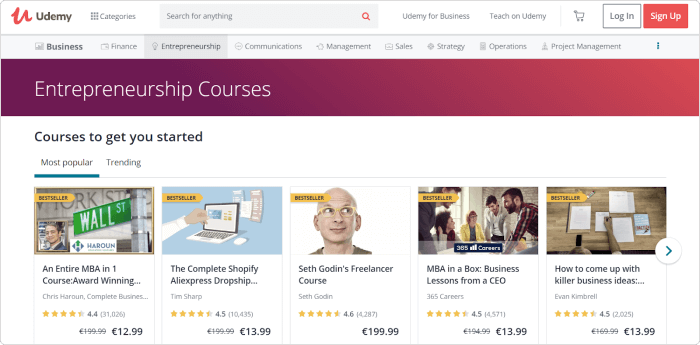How to Price Your Online Course (So It Actually Sells)

Are you totally lost when it comes to setting a price for your online course? You’re not alone. In this article, you’ll learn about principles, strategies, and the dos and don’ts of pricing your online course.
For most of us intellectual workers, pricing feels like a tough row to hoe. Ask too much, and you’ll scare them away; ask too little, and you’re leaving money on the table. So, how much to charge?
The best insights on the optimal price tag for your course are achieved after rolling it out to real-world customers. But first, you need a place to start. That is what we’ll cover in this blog post.
If you’re already an online coach with many sales under your belt, then chances are this post isn’t for you. Still, we’d love to know about your approach to pricing and experience in the comments below!
Pricing Principles for Selling Online Courses
Say you’ve created an awesome online course. How would you price it?
- I’ve spent 6 months developing it. Plus, I had to buy a camera and a green screen to record it. So, I’ll calculate all the costs and set the price that covers them or maybe a little higher.
- I’ll look for similar courses, see how much my competitors charge, and set a price that is around the average numbers.
- I’ll try to estimate how my course can benefit my learners and price it at a tangible value.
While all the options have the right to exist, the correct answer is “c.” Unlike traditional physical products, the results of intellectual work are way more difficult to evaluate, so it’s tempting to go with hours spent on production or equipment bought as pricing components. It’s a dead-end road.
When it comes to online courses, it’s better to come from a hypothesis that the people who the course benefits will readily pay a certain sum for this value. But which sum? Well, there’s no universal golden rule for that, so to some extent, it’s a bit like playing a guessing game.
But are there any pricing principles to consider along the way? Sure.
Stick to value-driven pricing
As opposed to a university degree, the peculiarity of online courses is that they aim to deliver specific results to their learners quickly. Some sort of transformation if you like, so there’s a clear before and after picture. How much is it worth to solve a problem for your learners or help them with this transformation? How much does it cost to guide them from point A to B?
Imagine you’re teaching the art of public speaking. There are plenty of people who become panic-stricken at the mere thought of being in front of an audience. If it was you, would you pay, say, $100 to learn how to gain confidence and finally get rid of that feeling in your stomach and sweaty palms? What if you can’t get a promotion because your voice trembles every time you’re making a presentation? Would you pay $1,000 to solve this problem?
It doesn’t really matter how many learning modules are there or how long is the course, as long as it helps people achieve the desired result.
The second thought here is that the amount of time put into a course’s production doesn’t necessarily directly correlate with its value.
Let’s say there are two public speaking coaches: John and Jim. John has over 10 years of experience and proven methods for turning a humble person into the next Brian Tracy. He can create a course on the fly simply by clicking the “record” button. Jim has zero experience in this field, so he’ll spend ten times longer to prepare the course (and it’ll still be shallower than John’s).
So, remember: it makes no sense to estimate the price other than by its value.
Think of the goal first
A top-down approach can also help you set the price. “Down” here is the exact price you want your learner to pay for a course. So, instead of guessing if this price is acceptable to the audience, look at the issue from another angle and ask yourself, “How much money would you like to earn with this course?” or “What monthly revenue would you receive from it, in an ideal world?”
There are two issues to consider here:
First, try to be realistic. Don’t get us wrong, we’re for positive thinking and love the movie The Secret. The idea here is to believe that a certain revenue is at least possible.
Second, don’t be afraid to be bolder. Although we’ve just suggested choosing a realistic goal, it doesn’t have to be so humble that you barely recoup your investment. If you feel that a certain sum sounds about right, it’s likely you could charge a little (or even much) more. Your comfort zone has nothing to do with the value your course delivers.
Let’s say you’d like to get $5,000 per month. Great! Use this amount to do the math in the next step.
Calculate how many people you’ll need to reach
Having the goal set, we can now get a rough estimate of how many sales do you need to make that sum.
There are two things you need to balance at this step:
- The cheaper the product, the more people that might buy it without hesitation, BUT you’ll need larger coverage to reach the goal.
- The higher the price, the fewer people that can afford it, BUT the fewer people you’ll need to sell to.
If you’re charging $10 for the course, you need to sell it 500 times every month to get $5,000. If it costs $1,000, you need just 5 sales. It may seem that it’s easier to persuade 5 people to buy something than 500, but here’s where a conversion rate comes in.
A conversion rate in our case is the percentage of visitors who came to your course page and paid to enroll. If 1,000 people visit your website, and 10 of them make a purchase, the conversion is 1%.
If you google the average conversion rate for online courses, it’ll be about 1,5% to 2%. 5% is a “great” result and less than 1% is obviously a “bad” conversion rate. Yet, it’s not that simple, since the rate is strongly correlated with the price tag.
For example, we’re still aiming at $5,000 in income per month.
| Course price | Sales needed per month | Expected conversion |
|---|---|---|
| $10 | 500 | 2,5% |
| $100 | 50 | 1,5% |
| $1,000 | 5 | 0,05% |
The conversion rates in this table are somewhat average and generic, but here’s an interesting thing to think about: How are you going to get sufficient reach to yield the targeted income? Do you have an existing audience that supports you?
| Price | Sales needed | Expected conversion rate | Reach needed |
|---|---|---|---|
| $10 | 500 | 2,5% | 20,000 |
| $100 | 50 | 1,5% | 3,333 |
| $1,000 | 5 | 0,05% | 10,000 |
In the table above, we see that the highest conversion is for the $10 course. At the same time, if you’d like to earn $5,000, you need to have 20,000 people visit your course page. That’s a lot for an author who doesn’t have an audience yet. So, this author, for example, can run an ad campaign on Instagram to attract visitors to his website. The average cost per click there is about $0,5 which means he’ll have to pay $10,000 for 20,000 visits that would probably bring in $5,000. That’s nonsense.
If you already have some courses for sale, the calculations will be more accurate since you have an idea of possible conversion for your content.
So, the key idea here is that you not only need to think about what price to set but also whether you’re able to ensure sufficient reach that doesn’t eat up all the profit.
All of the above values refer mainly to cases in which you sell courses under your own brand using digital storefronts like iSpring Market, for example, or similar software. The situation is quite the opposite if you are distributing courses via large online course platforms such as Udemy or Skillshare.
These platforms already have an audience of thousands of learners. How do they attract their learners? By offering a huge variety of content and low prices. Of course, this benefits both the platform and learners, but not an individual course developer. Udemy, for example, has its marketplace price standards, so you can’t charge more than $199,99. Plus, the competition, even in the lowest price tier, is really tough in every category.

It seems you need to be as famous as Seth Godin to charge more than $13,99 for your course.
Common Myths about Pricing Online Courses
Myth #1: There’s a fair price for this type of online course
There’s no right or wrong about what you charge for your course. Think of pricing as the result of two-party negotiations. One party is ready to buy at a certain price, the other is ready to sell. Let everyone in the market charge $9,99 for their courses; you don’t have to do the same if you believe your content is more valuable than that.
We’ve already discussed goals and values, so by this point, you should have an idea of what price is comfortable for you. If someone is ready to teach for less, well, it’s none of your business and shouldn’t reflect the value you deliver and your price. Charge $999 if it works for you and your learners.
Myth #2: I can’t charge THAT much because people can find this information elsewhere
It feels like there are no more secrets these days and we can find everything online. Instead of enrolling in paid courses, people can read expert blogs, surf the net, and study using their own trial-and-error method. If they have enough time, and this is the key.
With your course, you just help people get results faster and more efficiently. Plus, there are ways to make your course feel more valuable. For example, you can also offer a downloadable workbook or a one-to-one Skype consultation in addition to video lessons to give more justification for a higher price.
Myth #3: I can’t charge OVER $100 for the first course
You don’t need anyone’s permission to do so. If your course brings value, you can charge much more!
Myth #4: I can’t charge LESS than $100 for my course
If you make sales at a high price right away, accept our kudos. Don’t hesitate to receive the funds. But the path for the rest of us is to gain the audience’s trust little by little.
In our post on choosing a profitable niche for online courses, we discussed that the one and only foolproof strategy for creating a course is teaching others what you know best and have plenty of hands-on experience in. When you have a lot of material, it’s not a problem to share some valuable bits of it, as you have much more that can be packed into premium courses. And by the time you’re ready to offer your audience something that costs a pretty penny, you won’t be a stranger to them.
So, there’s nothing to be ashamed of in selling courses for $5, $10 or even giving some content away for free.
What’s Next?
We’d love to share a rule-of-thumb formula for pricing online courses, but there’s a slight hitch: it doesn’t exist. Seasoned course creators can share their experience, but such experience is a highly individual thing. What works in one case may not work in others. There are so many variables, so the only truly golden rule at pricing is test and iterate.
